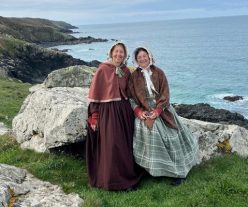We have moved the English blog over to augustasjourney.augustasresa.se.We are now in the process of adding all the pictures to the blogs as well.We started with the newest blogposts! Eventually, everything should work as before!
Cecilia’s Album: Thecla Hochschild (Grevenkop-Castenskiold) or Thecla Wilelius (Lindskog)?
Mången gladlig stundnjöto vi tillsammanoch i fröjd och gammanflög hvar snabb secund. Tiden aldrig hvilari sin snabba fart;ögonblicket ilaroch vi skiljas snart. Men i troget hjertauti fröjd och smärta fastän från dig skild,gömmer jag din bild (Many happy momentstogether we enjoyed,and in joy and happiness,the seconds quickly flew. Time never rests;in haste,the moment flies,and soon we part. But in my faithful heart,in joy and pain,though […]
Cecilia’s Album: Constance Carolina Nyström (Flensburg) – A Bishop’s Wife and Mother of 8
Sköna står hoppets rosor för dig, hvi söker du minnets?Hoppet och våren är slägt; minnet och hösten också.Dock om de gömmas till dess; bindas i förtid till kransFläta min blomma då in, gif henne vänligt din vård. I will not try to translate the poem into English. My interpretation of the poem is that one should have hope when young and that memories are for […]
Cecilia’s Album: Anna Charlotta Trapp – Boarding with Mademoiselle Frigel
IMG-7931 Two everlasting flowers blossom in the human mind One is friendship; the other memory May these two flowers remind you of your friend Charlotte! Who was Charlotte […]
Cecilia’s Album: Maria Amalia Emma Mariana (Marianne) Koch – Cecilia’s Sister
IMG-7921 De loin comme de près toujours je t’aimerai Afar or near I always love you, Dear Marianne Who was Marianne who wrote that short, sweet poem in French? The handwriting is impeccable. She didn’t include a last name or a date. Of course, with such an uncommon name in Sweden in the 1840s, there would have been no need to include a last name. […]
Cecilia’s Album: Carolina Åberg – Cecilia’s Cousin
IMG-7927 Bleibe Du auch von mir ferne, Immer froh von Herzen; Nimm mein Theil der Lust, und gerne Trag ich deins der Schmerzen! The poem is a stanza from a longer poem, Liebesfeier, written by Friedrich Rückert. Friedrich Rückert (1788-1866) was a German poet and translator who mastered over 30 languages. He is famous for his translations of oriental poetry. The stanza that Caroline copied […]
Cecilia’s Album: Maria Berlin (Böös) – And her Relationships with the Families Berlin, Hedin, and Westman
IMG-7932 Du reser hem, men jag blir kvar att sörja, och efter dig leta, dock likväl är det ljuvt att veta, att jag din vänskap ännu har. (You travel home, but I stay here to mourn, and for you look. Yet it is sweet for me to know, that still, I have your friendship.) Maria Charlotta Augusta Berlin’s family Maria Berlin was born on December […]
Happy New Year and Welcome 2023!
Happy New Year! I recently listened to an old cassette tape that had been in my drawer for years. On the tape, in my mother’s handwriting, I read: Christmas Stories and Music. I didn’t remember what was on the tape but had decided to finally transfer it to a digital file. I popped it into my new USB cassette player and waited. There were some […]
Cecilia’s Album: Louise Wener (Nordwall) – A Childhood at Svartsjö Kungsgård
Louise Wener wrote the following poem for Cecilia in January of 1844. IMG-7924 Oh! vilken önskan skall jag i din vänskapsbok skriva? Se, med fem ord står den här: Väninna, var lycklig i ditt liv. Oh! what wish should I give you in your memory book? Look, it is here in five words: Friend! Have a happy life. Who was Louise Wener? […]
Cecilia’s Album: Aurora Sophia af Wetterstedt – A Riddle to be Solved
It was quite common for friends to sign a memory card with just initials, or to leave out a few letters in the name. This card was signed A….re W……dt on the 16th of June. I assume it was given to Cecilia in June 1844 when she was about to leave Stockholm. But who was A….re W……dt? IMG-7919 Among your friends I will write a […]

